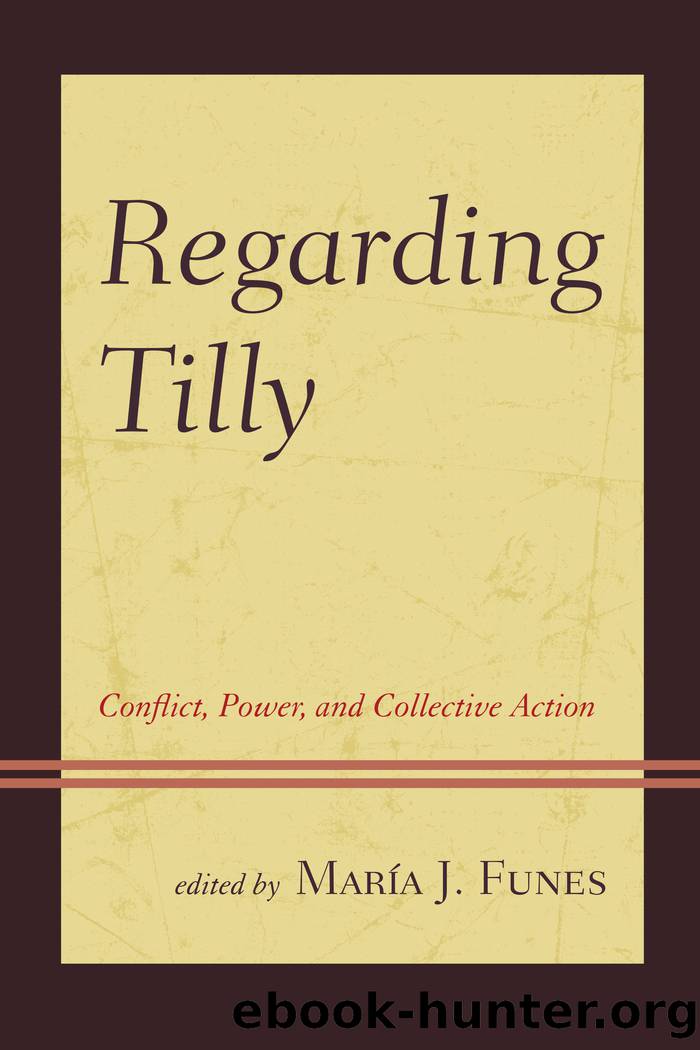Regarding Tilly by Funes María J.;

Author:Funes, María J.;
Language: eng
Format: epub
Tags: undefined
Publisher: University Press of America, Incorporated
Published: 2012-08-15T00:00:00+00:00
Conclusions
Charles Tillyâs contributions to our understanding and analysis of revolutionary phenomena have been widely recognized and used by scholars in the field. The dispute between Tilly and Theda Skocpol that began in the late1970s helped shape the debate on the question. For Tilly the analysis of revolutions should focus on the study of human action, whereas for Skocpol, it is the structural perspective that explained the phenomenon. Where Tilly spoke of political conflict, Skocpol found historical regularities; if for Tilly the main factors were the appearance of different contenders with aspirations to control state power, the popular support for these aspirations and the resistance of governments to them, for Skocpol what took precedence were national and international structures, as well as the organization of the state.
Tillyâs concept of revolution, established in constant dialogue with other social researchers, includes three main elements: the incompatibility of the contenders leading to a situation of multiple sovereignty, the support of a significant sector of the population and lastly, the transfer of power by force. Based on this, many authors such as Goldstone, Wickham-Crowley and Foran have contributed to the debate, turning to (or objecting to) Tillyâs categories. Similarly, together with McAdam and Tarrow, Tilly himself broadened the field of study coining the term, political contention, and explaining the conditions and processes required for the appearance of contenders for state power, and for their appearance to lead to a revolution. Likewise, the work of Thompson, who defined democratic revolutions as spontaneous popular uprisings that are able to overthrow a dictatorship, the work of Beissinger, who used this concept in his study of the color revolutions, and that of Bunce and Wolchik, who proposed the concept of electoral revolutions, were all developed on foundations laid by Tilly.
Tillyâs concept of revolution is especially relevant for the study of the so-called color revolutions (the Rose Revolution in Georgia in November of 2003; the Orange Revolution in Ukraine in November and December of 2004 and the Tulip Revolution in Kyrgyzstan in March of 2005). His extensive definitionâemphasizing the political dimension of the concept â, its relationship to collective action, the description of the stages of the revolutionary process, from initial protests to the transfer of power, and in short, his epistemological and ontological contributions, are very useful tools for analyzing this phenomenon; that is, post-electoral protests, which after a phase of contention, manage to bring about a transfer of power through non-institutional channels.
Thus, following Tillyâs classic definition of revolution, we can tentatively consider a conceptualization of these processes as post-electoral revolutions, stressing three of their main elements, while making the appropriate clarifications: the incompatibility of the contenders and the opening up of a situation of multiple sovereignty, the support of a significant sector of the population and, lastly, the transfer of power by force, elements that have all been found in what took place in Georgia in 2003, Ukraine in 2004 and Kyrgyzstan in 2005.
Download
This site does not store any files on its server. We only index and link to content provided by other sites. Please contact the content providers to delete copyright contents if any and email us, we'll remove relevant links or contents immediately.
Chaco's Northern Prodigies : Salmon, Aztec, and the Ascendancy of the Middle San Juan Region after AD 1100 by Paul F. Reed(338)
Law Enforcement Interpersonal Communication and Conflict Management by Brian Douglas Fitch(331)
Digital International Relations by Unknown(324)
Critical Perspectives on Human Security : Rethinking Emancipation and Power in International Relations by David Chandler; Nik Hynek(315)
The Enduring Color Line in U.S. Athletics by Krystal Beamon Chris M. Messer(309)
Skilled interpersonal communication: Research, theory and practice, Fifth edition by Owen Hargie(309)
Evidence-Based Policy Making in Labor Economics by Hamermesh Daniel S.;Nottmeyer Olga K.;Nottmeyer Olga;King Sarah;King Sarah;King Sarah;(277)
EPSO CAST Political affairs EU policies: How to succeed in the selection procedure by Franco Reverte José María(272)
Writing Public Policy - A Practical Guide to Communicating in the Policy Making Process by Catherine F. Smith(256)
Threshold Concepts in Women's and Gender Studies by Christie Launius Holly Hassel(249)
Criminological Theory in Context by John Martyn Chamberlain(249)
Tibeton Yoga Its Secret Doc by Evans-Wentz(245)
Positive Psychology and Spirituality in Counselling and Psychotherapy (Conflict, Ethics, and Spirituality, 12) by unknow(245)
Rothschild and Early Jewish Colonization in Palestine (Geographical Perspectives on the Human Past) by Ran Aaronsohn(244)
Social Problems, Social Issues, Social Science by James Wright(243)
Play in child development and psychotherapy: toward empirically supported practice by Sandra W. Russ(239)
Cognitive Development in Infancy and Childhood (Elements in Child Development) by Mary Gauvain(235)
Latin American Politics and Society by Gerardo L. Munck & Juan Pablo Luna(208)
What Makes a Social Crisis?: The Societalization of Social Problems by Jeffrey C. Alexander(206)
